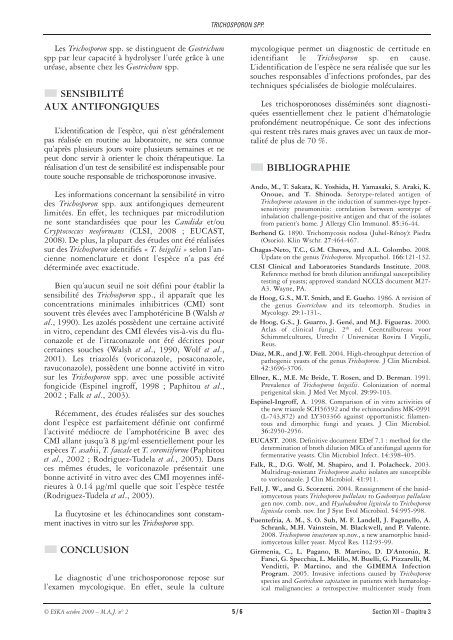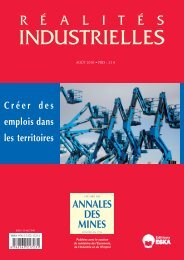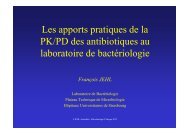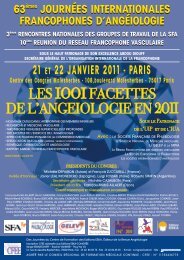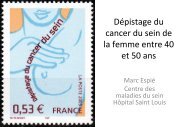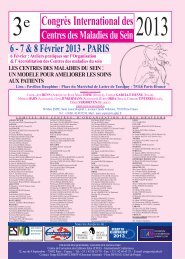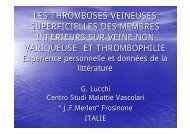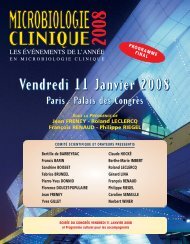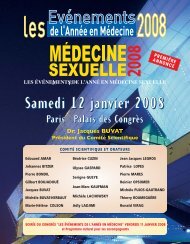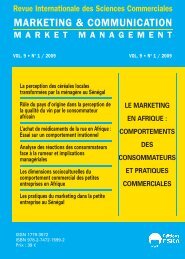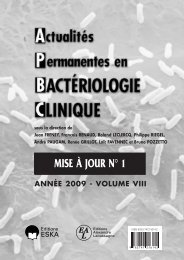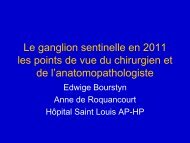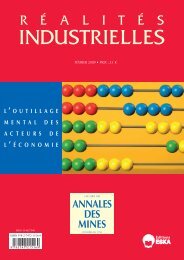mise à jour n° 2 année 2009
mise à jour n° 2 année 2009
mise à jour n° 2 année 2009
You also want an ePaper? Increase the reach of your titles
YUMPU automatically turns print PDFs into web optimized ePapers that Google loves.
Les Trichosporon spp. se distinguent de Geotrichum<br />
spp par leur capacité <strong>à</strong> hydrolyser l’urée grâce <strong>à</strong> une<br />
uréase, absente chez les Geotrichum spp.<br />
SENSIBILITÉ<br />
AUX ANTIFONGIQUES<br />
L’identification de l’espèce, qui n’est généralement<br />
pas réalisée en routine au laboratoire, ne sera connue<br />
qu’après plusieurs <strong>jour</strong>s voire plusieurs semaines et ne<br />
peut donc servir <strong>à</strong> orienter le choix thérapeutique. La<br />
réalisation d’un test de sensibilité est indispensable pour<br />
toute souche responsable de trichosporonose invasive.<br />
Les informations concernant la sensibilité in vitro<br />
des Trichosporon spp. aux antifongiques demeurent<br />
limitées. En effet, les techniques par microdilution<br />
ne sont standardisées que pour les Candida et/ou<br />
Cryptococcus neoformans (CLSI, 2008 ; EUCAST,<br />
2008). De plus, la plupart des études ont été réalisées<br />
sur des Trichosporon identifiés « T. beigelii » selon l’ancienne<br />
nomenclature et dont l’espèce n’a pas été<br />
déterminée avec exactitude.<br />
Bien qu’aucun seuil ne soit défini pour établir la<br />
sensibilité des Trichosporon spp., il apparaît que les<br />
concentrations minimales inhibitrices (CMI) sont<br />
souvent très élevées avec l’amphotéricine B (Walsh et<br />
al., 1990). Les azolés possèdent une certaine activité<br />
in vitro, cependant des CMI élevées vis-<strong>à</strong>-vis du fluconazole<br />
et de l’itraconazole ont été décrites pour<br />
certaines souches (Walsh et al., 1990, Wolf et al.,<br />
2001). Les triazolés (voriconazole, posaconazole,<br />
ravuconazole), possèdent une bonne activité in vitro<br />
sur les Trichosporon spp. avec une possible activité<br />
fongicide (Espinel ingroff, 1998 ; Paphitou et al.,<br />
2002 ; Falk et al., 2003).<br />
Récemment, des études réalisées sur des souches<br />
dont l’espèce est parfaitement définie ont confirmé<br />
l’activité médiocre de l’amphotéricine B avec des<br />
CMI allant jusqu’<strong>à</strong> 8 µg/ml essentiellement pour les<br />
espèces T. asahii, T. faecale et T. coremiiforme (Paphitou<br />
et al., 2002 ; Rodriguez-Tudela et al., 2005). Dans<br />
ces mêmes études, le voriconazole présentait une<br />
bonne activité in vitro avec des CMI moyennes inférieures<br />
<strong>à</strong> 0.14 µg/ml quelle que soit l’espèce testée<br />
(Rodriguez-Tudela et al., 2005).<br />
La flucytosine et les échinocandines sont constamment<br />
inactives in vitro sur les Trichosporon spp.<br />
CONCLUSION<br />
Le diagnostic d’une trichosporonose repose sur<br />
l’examen mycologique. En effet, seule la culture<br />
TRICHOSPORON SPP.<br />
mycologique permet un diagnostic de certitude en<br />
identifiant le Trichosporon sp. en cause.<br />
L’identification de l’espèce ne sera réalisée que sur les<br />
souches responsables d’infections profondes, par des<br />
techniques spécialisées de biologie moléculaires.<br />
Les trichosporonoses disséminées sont diagnostiquées<br />
essentiellement chez le patient d’hématologie<br />
profondément neutropénique. Ce sont des infections<br />
qui restent très rares mais graves avec un taux de mortalité<br />
de plus de 70 %.<br />
BIBLIOGRAPHIE<br />
Ando, M., T. Sakata, K. Yoshida, H. Yamasaki, S. Araki, K.<br />
Onoue, and T. Shinoda. Serotype-related antigen of<br />
Trichosporon cutaneum in the induction of summer-type hypersensitivity<br />
pneumonitis: correlation between serotype of<br />
inhalation challenge-positive antigen and that of the isolates<br />
from patient’s home. J Allergy Clin Immunol. 85:36-44.<br />
Berhend G. 1890. Trichomycosis nodosa (Juhel-Rénoy): Piedra<br />
(Osorio). Klin Wschr. 27:464-467.<br />
Chagas-Neto, T.C., G.M. Chaves, and A.L. Colombo. 2008.<br />
Update on the genus Trichosporon. Mycopathol. 166:121-132.<br />
CLSI Clinical and Laboratories Standards Institute. 2008.<br />
Reference method for broth dilution antifungal susceptibility<br />
testing of yeasts; approved standard NCCLS document M27-<br />
A3. Wayne, PA.<br />
de Hoog, G.S., M.T. Smith, and E. Gueho. 1986. A revision of<br />
the genus Geotrichum and its teleomorph. Studies in<br />
Mycology. 29:1-131-.<br />
de Hoog, G.S., J. Guarro, J. Gené, and M.J. Figueras. 2000.<br />
Atlas of clinical fungi. 2 th ed. Ceentralbureau voor<br />
Schimmelcultures, Utrecht / Universitat Rovira I Virgili,<br />
Reus.<br />
Diaz, M.R., and J.W. Fell. 2004. High-throughput detection of<br />
pathogenic yeasts of the genus Trichosporon. J Clin Microbiol.<br />
42:3696-3706.<br />
Ellner, K., M.E. Mc Bride, T. Rosen, and D. Berman. 1991.<br />
Prevalence of Trichosporon beigeilii. Colonization of normal<br />
perigenital skin. J Med Vet Mycol. 29:99-103.<br />
Espinel-Ingroff, A. 1998. Comparison of in vitro activities of<br />
the new triazole SCH56592 and the echinocandins MK-0991<br />
(L-743,872) and LY303366 against opportunistic filamentous<br />
and dimorphic fungi and yeasts. J Clin Microbiol.<br />
36:2950-2956.<br />
EUCAST. 2008. Definitive document EDef 7.1 : method for the<br />
determination of broth dilution MICs of antifungal agents for<br />
fermentative yeasts. Clin Microbiol Infect. 14:398-405.<br />
Falk, R., D.G. Wolf, M. Shapiro, and I. Polacheck. 2003.<br />
Multidrug-resistant Trichosporon asahii isolates are susceptible<br />
to voriconazole. J Clin Microbiol. 41:911.<br />
Fell, J. W., and G. Scorzetti. 2004. Reassignment of the basidiomycetous<br />
yeats Trichosporon pullulans to Guehomyces pullulans<br />
gen nov. comb. nov., and Hyalodendron lignicola to Trichosporon<br />
lignicola comb. nov. Int J Syst Evol Microbiol. 54:995-998.<br />
Fuentefria, A. M., S. O. Suh, M. F. Landell, J. Faganello, A.<br />
Schrank, M.H. Vainstein, M. Blackwell, and P. Valente.<br />
2008. Trichosporon insectorum sp.nov., a new anamorphic basidiomycetous<br />
killer yeast. Mycol Res. 112:93-99.<br />
Girmenia, C., L. Pagano, B. Martino, D. D’Antonio, R.<br />
Fanci, G. Specchia, L. Melillo, M. Buelli, G. Pizzarelli, M.<br />
Venditti, P. Martino, and the GIMEMA Infection<br />
Program. 2005. Invasive infections caused by Trichosporon<br />
species and Geotrichum capitatum in patients with hematological<br />
malignancies: a retrospective multicenter study from<br />
© ESKA octobre <strong>2009</strong> – M.A.J. <strong>n°</strong> 2 5 / 6 Section XII – Chapitre 3


